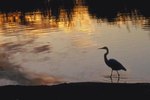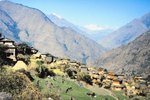
If you're wondering if the blue bird of happiness has finally made his way to your yard, take a second look and confirm it isn't the blue jay of happiness. Both birds spot beautiful blue plumage, however they're very different birds. These guys differ in size, plumage, diet and habitat.
Plumage, Bright Colors Draw Attention
If you're partial to blue, either of these birds will appeal to you. Both the eastern and western blue bird sport bright blue plumage contrasting with a reddish-brown breast. The male mountain blue bird has a sky blue body, head and wings and a white belly. The female isn't as brightly colored as the male, with a brownish tone mixed with blue over her body. Blue birds run between 6.5 and 8.5 inches in length. The blue jay is larger, ranging in size from 10 to 12 inches. He's more flamboyant than the blue bird, with a white or gray breast topped with blue plumage. The perky crest on his head also makes him easily identifiable.
From Forests to Fields
The blue bird name indicates where you'll find him; the eastern version is east of the Rockies, ranging from Canada to Honduras. Western blue birds are west of the Rockies, from Canada to Mexico and mountain blue birds overlap into the eastern and western blue bird's territories. The mountain blue bird is found in agricultural areas and groves of trees, while the western blue bird prefers open woodlands. The eastern blue bird can be seen in open country with trees and are common in pastures, suburban parks, backyards and fields. The blue jay is common throughout most of North America, gradually increasing his range into the Northwest. He lives in forests -- though he prefers forest edges to deep forest -- as well as urban and suburban areas. He especially appreciates oak trees and bird feeders.
Blue Birds Get a Little Nutty
Each of the three blue birds enjoys dining on insects, but will eat fruit such as blueberries, raspberries and currants. Spiders, caterpillars, beetles and crickets are a mainstay of this guy's diet. The blue jay has a reputation of being a thief for his supper, however it's mostly undeserved. Instead of robbing nests for eggs or nestlings, this fellow actually prefers a diet of nuts and seeds. He will eat insects such as grasshoppers and beetles, as well as injured vertebrates.
Looking For Love
All blue birds may mate more than once during the year. The eastern blue bird usually has two to seven eggs in a clutch, requiring two to three weeks to hatch. The mountain blue bird has a larger clutch, of four to eight eggs, and the western blue bird's clutch may be as small as two eggs or as large as eight. Like their eastern family member, it takes about two or three weeks for their eggs to hatch. The blue jay only mates once in a year, with a clutch size of two to seven, and will incubate her eggs for almost three weeks.
References
- Cornell Lab of Ornithology: All About Birds: Blue Jay
- National Geographic: Blue Jay
- National Geographic: Blue Bird
- Cornell Lab of Ornithology: All About Birds: Eastern Blue Bird
- Cornell Lab of Ornithology: All About Birds: Mountain Blue Bird
- Cornell Lab of Ornithology: All About Birds: Western Blue Bird
Photo Credits
-
Jupiterimages/Photos.com/Getty Images




